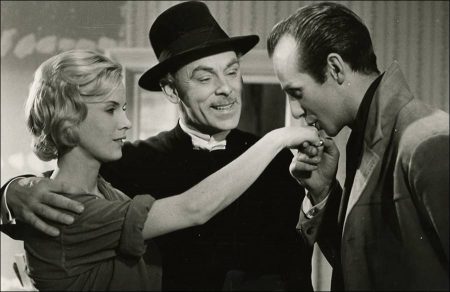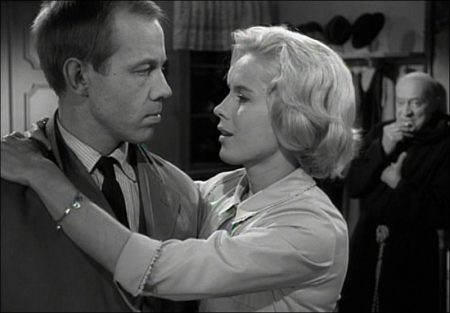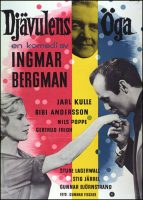The Devil’s Eye movie storyline. An actor presents a comedy in three acts. That story involves Satan who has developed a painful sty, which is the result of something tumultuous happening on earth. He learns from his advisers that that tumultuous thing is the pure chastity of twenty year old Nordic beauty Britt-Marie, the daughter of a vicar, she who is soon to be married to her longtime beau, Jonas.
To get rid of his sty, Satan knows he has to get someone to defile Britt-Marie before her marriage, or else her purity could cause a ripple effect which would be disastrous for him beyond the sty. Satan pulls out the big guns in the form of Don Juan, who has been in hell for three hundred years and who Satan has punished with continually performing the act of seduction on women but never being able to complete the seduction to the actual act of love.
Beyond Satan reducing his punishment, Don Juan agrees only if his longtime servant Pablo can also be sent to earth with him on this assignment. While Pablo can’t help but try to indulge in some of earth’s forbidden pleasures, Don Juan may find a slightly different soul in Britt-Marie than he anticipates and thus a slightly different challenge.
The Devil’s Eye (Swedish: Djävulens Oga) is a 1960 Swedish fantasy-comedy film written and directed by Ingmar Bergman. The film stars are Jarl Kulle, Bibi Andersson, Stig Järrel, Gertrud Fridh, Nils Poppe, Sture Lagerwall, Georg Funkquist, Gunnar Sjöberg, Gunnar Björnstrand, Kristina Adolphson and Torsten Winge.
Film Review for The Devil’s Eye
A director or actor’s passing is often an excuse for a cash-in, with DVD boxsets popping up before the coffin goes the other way. A re-issued Ingmar Bergman collection hardly feels cynical though; any excuse for one. After his death last month, Woody Allen called him the greatest “film artist” of all time, and it’s an accurate description of a man who was more than an auteur. He didn’t make someone else’s script his own film, he tried to make art. His name is synonymous: if you want to say highbrow, you say Bergman.
Of course, even the greatest men have skeletons in their closet, (Or is it that they become great because of them?), and the The Devil’s Eye is Bergman’s. Styled as a comedy, it’s a strange story of sin and marriage that never really rises above fanciful fairytale.
The devil has a stye in his eye, because of a small blip on earth: a young woman (Bergman regular Bibi Andersson), destined for Hell, is chaste. He sends casanova Don Juan – sentenced to an eternity of temptation – to seduce the engaged beauty. Taken for a stranger, her father, a rural vicar, invites Juan (and his faithful servant) into his home. But as tempting for the pair is the naive and lost minister’s wife, a woman as dead as the devil’s minions, on the inside. Think Cruel Intentions meets The Importance Of Being Earnest: redemption through seduction, but whimsical (although here that’s another word for annoying).
Bergman was often at his best when he played with film conventions, as in his masterpiece Persona, as the film burns up on screen, leaving the horror of life (or death) underneath, and it’s something attempted less successfully here. His cinematographer, Gunnar Björnstrand, narrates the tale as if it were the evening news, whilst a demon watches over Juan and randy servant Pablo. Films don’t need high budgets to give flights of fantasy a reality, it’s true, but sometimes artistic sincerity can’t make up for the gaps in production, and sadly The Devil’s Eye falls into that category.
In his native Sweden, Bergman was once as known for his theatre works as his films, and The Devil’s Eye exudes chamber piece theatricality in every line, in every movement across a room, in every pause in motion in gesture and speech, in what is left unsaid. They say that geniuses can keep mining the same material and still come up with gold, and for the most part, it’s true of Bergman.
He was at his best when his characters, lost without realising, brought out their anxieties in sparsely furnished middleclass rooms (no Ikea in sight), dissecting their own hopes and dreams, fears and woes for the audience. In Saraband, his final work, a couple’s reunion after 30 years leaves them unable to avoid trivialities; words aren’t enough to bridge the gap of time between them. But here the silences are mute, and Bergman fails to take the story beyond mere fable.
As a result, you’re left floundering for meaning. The Devil sends temptation to the household, but the mother and daughter avoid sinning even as they do, and his ambassador even finds a grace of sorts. It’s a strange idea, one that sits uneasily next to most of Bergman’s flawed characters. Unusual, too, for Bergman is the idea that marriage, that love, might work despite any obstacles, especially for a man who married five times himself. Overall, a poor and unusually uncertain work in the Bergman canon.
The Devil’s Eye (1960)
Directed by: Ingmar Bergman
Starring: Jarl Kulle, Bibi Andersson, Stig Järrel, Gertrud Fridh, Nils Poppe, Sture Lagerwall, Georg Funkquist, Gunnar Sjöberg, Gunnar Björnstrand, Kristina Adolphson, Torsten Winge
Screenplay by: Ingmar Bergman
Production Design by: Edvin Laine, P.A. Lundgren, Mario Soldati
Cinematography by: Gunnar Fischer
Film Editing by: Oscar Rosander
Costume Design by: Mago
Makeup Department: Börje Lundh
Music by: Erik Nordgren
MPAA Rating: None.
Distributed by: Janus Films
Release Date: October 17, 1960
Visits: 128



